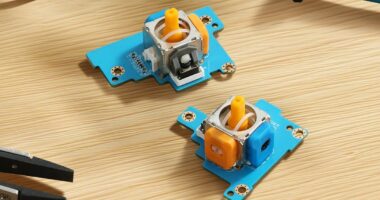Share this @internewscast.com
In an unexpected twist, DJI, renowned for its drones and cameras, has ventured into the world of robotic vacuums. The company recently launched the DJI Romo in Europe, following its initial release in China over the summer. This innovative gadget combines vacuuming and mopping capabilities, featuring a unique transparent design. However, don’t expect this device to take flight; it’s firmly grounded, utilizing DJI’s renowned navigation expertise.
At the IFA trade show in September, I had the opportunity to preview this see-through cleaning device. Although I didn’t witness it in action due to the limited space behind DJI’s expansive exhibit, I did have the chance to examine its hardware, which boasts some intriguing technology.


The Romo is available in three versions: the top-tier, fully transparent Romo P, starting at €1,899 (approximately $2,200); the Romo A, which combines a transparent robot with a white base, priced at €1,599 (around $1,700); and the all-white Romo S, available for €1,299 (around $1,500). These models are now purchasable across Europe via store.dji.com.
In terms of specifications, the models are largely similar, with the P’s dock offering a few additional features. Essentially, the extra €300 for the P model is for the visually appealing transparent design.

While I appreciate a piece of transparent technology as much as any gadget enthusiast, I’m cautious about how well this will fit into a living space after months of floor cleaning. Nonetheless, from a reviewer’s standpoint, it was fascinating to see the internal workings of both the vacuum and its dock.
Despite its allure, this vacuum carries a hefty price tag considering its specifications, and transparent vacuums aren’t a new concept (thanks to Dyson’s innovations). Apart from its navigation system, which we’ll delve into shortly, the Romo series bears a strong resemblance to Roborock’s more affordable Qrevo Curv line. Both feature curved base stations and employ a split roller brush design for efficient hair collection, paired with an extendable side brush for thorough corner cleaning.
1/4
They also share the same dual-spinning mop pad design, and both can recognize carpet and lift the mops to avoid mopping it. The Romos offer higher suction power — 25,000Pa — than the Curvs, along with a larger, 164ml onboard water tank, which means the bot won’t have to go back to the dock as often to refill.
The model I saw at IFA was the Romo P, and while the overall design resembles the Curv, both the base station and the robot itself are bigger, heavier, and substantially taller — the better to accommodate all its navigation tech. This is where DJI’s expertise clearly comes into play. The robot uses a combination of dual fish-eye vision sensors and wide-angle dual-transmitter solid-state lidar, technology derived from its flagship drones.

According to DJI, this enables “millimeter-level obstacle sensing technology” that, combined with machine learning, allows the Romo to detect objects as thin as a 2mm charging cable or even a playing card. That should mean it can navigate your home effectively without getting tripped up by common objects like cords and socks.
The Romo can detect objects as thin as a 2mm charging cable or even a playing card
While most flagship robovacs have top-notch obstacle detection tech, this sounds like a significant step up. Roborock’s flagship StarSight navigation system on its top-of-the-line models can only identify objects as small as 2cm by 2cm.
I’ve tested a lot of robot vacuums and found that those with cameras are much better navigators, and the combination of lidar and vision sensors in the Romo looks promising.
1/4
The Romo’s self-cleaning base station also has a few unique features, including a slot for a “floor deodorizer solution” alongside the standard cleaning solution in the P model. This gives you the option to make the floors smell nice after vacuuming rather than doing a full mop with cleaning solution, which is a nice upgrade. It also features a high-pressure jet system to clean the mop pads, along with hot air for drying.
Another neat design reduces the noise level. DJI says the dock has a sound-suppression system with long muffler ducts and muffler chambers that dampen the very loud screeching noise common in self-emptying stations by 80 percent, to just 65 decibels. You can see these through the transparent paneling on the P model, which is very cool. But I maintain that I would like to see one again in six months’ time before deciding if see-through is a smart design choice or a clear mistake.
The Romo doesn’t have a US launch date, but we plan to test the European model and follow up with a full review.
Photos by Jennifer Pattison Tuohy / The Verge






